 |
||
|
||
| ||
TABLE OF CONTENTSSuch an intriguing title. Considering the frequency difference between 256-MB and 512-MB models of GeForce 7800 GTX, a rare Ultra card dares to dream of such gains! We remember the maximum frequency difference between GeForce FX 5800 Ultra and 5800 - 100 MHz on the core. It's still smaller in case of 6800 Ultra and 6800GT. And in this case the difference is 120 MHz core frequency and the cards bear the same title! Indeed wonderful things happen inside marketing minds! They sometimes call different names to each revision of the same chip and use a different title for the product on the whole. And now they use the same title for absolutely different cards, their titles differing only in memory capacity. Even NVIDIA employees are confused, when they are asked the justified question: "Will you actually launch Ultra as well? If not, why didn't you use this suffix for this card?" There is no intelligible answer. However, one thing we know for sure: There will be no 7800 Ultra! The next product, to be faster than even the current flagship, will bear another title. That's why the title of our article is just to pick your interest :) I shall not amplify on the future that awaits the market of 3D accelerators in early 2006. All in good time. But it's quite clear today that GeForce 7800 GTX 512MB pretends to the throne and crown as the fastest gaming accelerator in the world. Yep, they need to give an accelerator such a long and complex title, in order to distinguish it from what we previously saw with 256-MB of memory. The GPU itself has got this very title: GeForce 7800 GTX 512. Of course, it's the same G70. Nothing new has been introduced, the same revision (A2). It was decided in summer to select the fastest chips, capable of running at super high frequencies, and reserve them for future use. There was no information at that time on ATI RADEON X1800 XT, its characteristics, and frequencies. So NVIDIA made various moves, in order to make provisions for possible counter measures, if the competitor turned out faster than GeForce 7800 GTX 256MB. That's was a very prescient decision. Now that the advantage of X1800 XT 512MB over 7800 GTX 256MB is known to be not very large, sometimes it even lags behind, it's time to unleash the accumulated potential. Indeed, the number of G70 chips, selected for 512-MB cards, is not sufficient for the mass-scale shipments of middle-end and cheap solutions. But it's quite enough to start manufacturing accelerators for over 600 USD. Besides, they still continue to select GPUs. As the process is being streamlined (this process may actually lead to the 100% yield of effective chips), there may appear more such chips than demanded for super expensive 512-MB cards. So a part of regular 7800GTX 256MB cards may just as well be equipped with such super-potential GPUs, a real treat to overclockers. I repeat, it's just an assumption! The demand for 512-MB products may be so high that all selected chips will go to these cards only. Let's get back to X1800 XT. NVIDIA obviously launched the new solution to counterbalance ATI's flagship. Exactly when the Canadian company announced that their latest accelerators were available in stores. The price for 7800 GTX 512 cards is intentionally higher than the initial MSRP of the X1800 XT ($549) by $100 - 649 USD. It's no secret that there are few X1800-based products so far, the demand is high, prices are raised sky-high! Of course, you cannot buy a X1800 XT card for $550 in mid November, 2005. You won't find it for $600 either. The price will be higher. Even its MSRP is raised to $599. Why not NVIDIA profit from this situation? But we must not forget that the prime cost of the 7800 GTX 512 is still too high. But let's examine the card.
Video card
When we just started to review the 7800 GTX, we noted that NVIDIA launched the product on a PCB, designed for 512 MB of memory, as half of memory seats was empty. It's clear that this PCB was designed, when a 512-MB cards were planned to run at the same frequencies as their 256-MB counterparts. Subsequent events changed the plans, NVIDIA required faster memory chips, but the 7800 GTX 256MB PCB was designed only for 144-pin BGA chips. But faster memory is manufactured in the form of 136-pin chips. Besides, if the PCB has to be overhauled, it should use 512 Mbit modules to reduce the number of on-board chips. Thus, we got the GeForce 7800 GTX 512, which PCB is similar to the one used in the X1800 XT. The 7800 GTX 512 is equipped with two DVI jacks, it supports VIVO.
As usual, the cooling system covers the heart of a video card - GPU. As we can see, after a chip is selected, it's marked as GeForce 7800 GTX 512 to distinguish it from other chips, not capable of operating at higher frequencies. The chip is manufactured on Week 38 of this year, that is quite recently.
It's our base-line material on the new product, so we shall not review their boxes and bundles.
I want to show you how the card looks in a PC case.
Of course, you may pay attention to an attractive SLI connector and speculate what a pair of such cards can yield in SLI mode! But we had no other card at the time of tests. I tried to enable SLI mode with ASUS GeForce 7800 GTX TOP, as this 256-MB card can operate at very high frequencies.
But no miracles happened. Even though the limitation of totally identical cards running in SLI mode is lifted, they must at least be identical in their DeviceID. But GeForce 7800 GTX 512MB differs from its 256-MB counterpart in this respect. Even Driver 81.89 offers two lines with the same title (7800 GTX). That's why SLI is impossible in this case. By the way, as the new card has a different DeviceID, it cannot work with Drivers below Version 81.89. Another 7800 GTX 512 card will appear in our lab in the nearest future, then we shall be capable of testing SLI with such super cards.
Installation and DriversTestbed configurations:
 As we can see, the temperature background does not exceed the reasonable limits (in a closed PC case without additional cooling). Now what concerns overclocking. I expected that the selected G70 would run at 550 MHz nearly at maximum output, I was wrong. The card worked fine at 620/1930 MHz! It's clear that the memory running at 900 (1800) MHz can demonstrate a decent potential, but the core running at 620 MHz is a miracle! By the way, it should be noted that BIOS in these cards is not limited to 27 MHz steps to change the frequency, which we had seen in older cards. Frequencies can be changed in a usual way. But all the three core frequencies are tied to each other as before, they cannot be controlled individually. Test results: performance comparisonWe used the following test applications:
I want to put things right concerning the HQ mode on the diagrams. That's not High-Quality in drivers, it's AA or AF modes of high quality: NVIDIA - TAA, ATI - AAA and AF High Quality. Game tests that heavily load vertex shaders, mixed pixel shaders 1.1 and 2.0, active multitexturing.FarCry, Research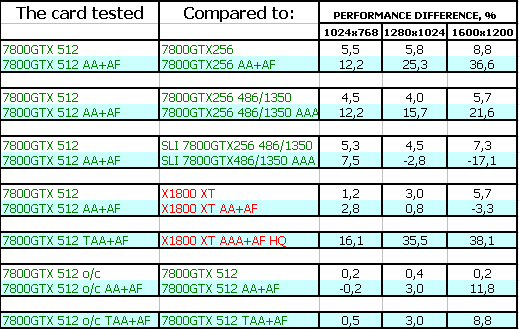 Considering that the game is limited by a CPU even in 1600x1200 with AA+AF using such powerful cards, the differences are not that large. But the performance indeed grows relative to the 256-MB modification. There is approximate parity with the X1800XT. Despite the excellent result in HQ modes, we should always take into account that the anisotropy quality in the X1800XT is much higher in this mode. Game tests that heavily load vertex shaders, pixel shaders 2.0, active multitexturing.F.E.A.R. v.1.01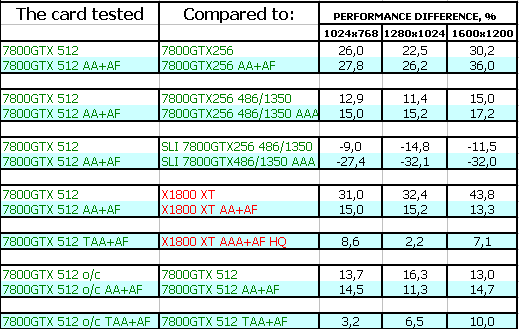 The new card demonstrates very good results in this test! Even the previous flagship (overclocked 7800 GTX 256MB from ASUS) is left far behind. Obvious victory over the X1800 XT as well. Only the GeForce 7800 GTX SLI, with its sky-high price, still takes up the lead. HQ mode brings the competitors to parity, despite the 8% advantage of the 7800 GTX 512, X1800 XT offers better anisotropy quality in this mode. Splinter Cell Chaos Theory HQ mode changes the situation here, even though the superiority of the 7800 GTX 512 over the X1800 XT is evident. We can see the Canadian product scoring off, also considering that its AF quality is higher in this case. There is nothing new in other respects: the frequencies play their role and the 7800 GTX 512 heavily outperforms its 256-MB competitors. It just doesn't catch up with the 7800 GTX SLI. Call Of Duty 2 DEMO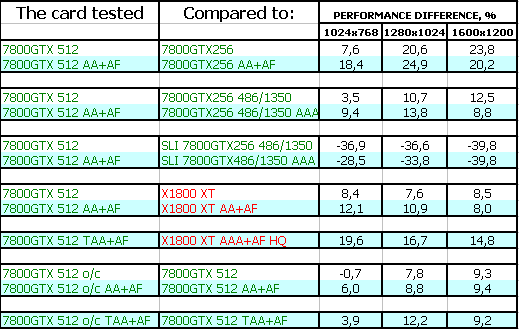 This test demonstrates an evident victory of the 7800 GTX 512 on all the fronts. Half-Life2: ixbt01 demo
 Well... this one shows that the CPU provides up to 100 FPS in all modes and resolutions... Hmm, it's time we remove this game from our tests. It shows nothing even in 1600x1200 AA+AF.
Game tests that heavily load pixel pipelines with texturing, active operations of the stencil buffer and shader unitsDOOM III High mode Chronicles of Riddick, demo 44
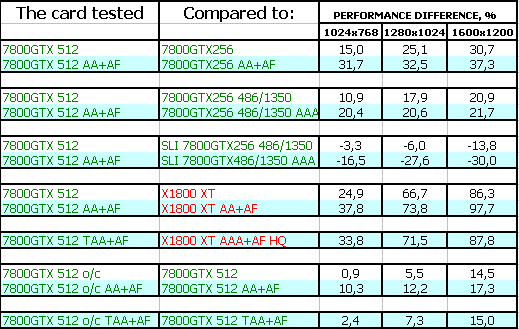 Everything is clear here: OpenGL games, NVIDIA's products are beyond competition so far. The advantage over the 7800 GTX 256MB is quite large!
Synthetic tests that heavily load shader units3DMark05: MARKS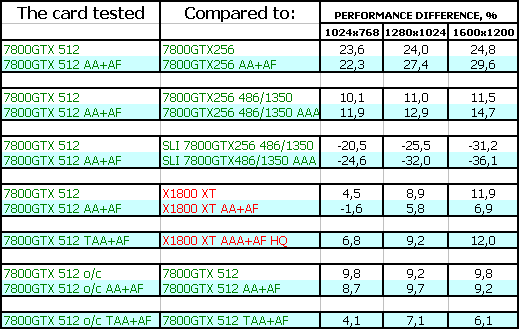 When we tested the X1800 XT, we paid attention to the fact that 3DMark05 results were very different from the general trend demonstrating a great victory of the ATI product, not to be seen in any game test. The reason is clear: these are all purely shader tests here, while the Canadian company has been specializing in the computational capacity of its GPUs for a long time already. But here is a match to it. The 550 MHz core and 24 pipelines did their part, we can see that the 7800 GTX 512MB is victorious. And the overclocked card gets over the psychological mark of 10 000 points.
ConclusionsNVIDIA GeForce 7800 GTX 512MB is currently the fastest 3D gaming accelerator! That's a proved fact. It may be on a par with the X1800 XT sometimes, but on the whole it's much faster. Besides, the card possesses an excellent overclocking potential! Yes, its price is higher than that for the X1800 XT: $640 versus $599. But considering that the 7800 GTX 512MB is already available on sale (before the announcement!) and many cards are already on their way to the stores, their price may just as well drop to $600 or even lower. The same cannot be said about the X1800 XT, which are in deficit so far, their prices are sky-high (in mid November). It should also be noted that the new cooler and a changed PCB in the 7800 GTX 512 compared to the 256-MB counterpart had a positive effect on video card's temperatures. The card is not that fiery hot as it used to be. The core overheating does not exceed 80 degrees even in case of super overclocking to 620 MHz. The cooling system is very quiet, the rotational speed of the fan is below 1000 rpm, the hot air is driven out of a PC case. So, I like the card very much, except for its price. The only drawback I can mention is the bad anisotropy quality in driver settings in Quality mode. This drawback disappears in High Quality mode, but it disappears together with some useful optimizations. So it's difficult to choose what is better: Quality or High Quality in driver settings. But this feature concerns all 7800 cards, not only this one. This situation is better in the X1800 XT. Besides, it offers an AF quality choice. On the whole, we should note once again the impressive NVIDIA's strategy this year. Fortune shines on this company and it offers very interesting products. I'll not repeat myself about ATI's lagging behind, it has been said many times. I hope the company will manage to win back gamers' attention and love by relatively mass-scale shipments of its products and a price drop for the X1800 XT. But I must establish a fact that Hi-End products from NVIDIA are more attractive (no matter what red-white fans say, they cannot beat the facts). There is information that the Canadian company recommends its partners to raise operating frequencies of the X1800 XT. If that's true, it will be very interesting to see what will come out of it. But considering the overclocking potential of the 7800 GTX 512 and the appearance of samples, officially overclocked to 580 MHz, it seems to me that ATI will fail in this attempt. The Canadians can only increase their efforts to make X1800 XT cards available and drop its prices. Well, and get ready for a new round in the battle to take place in Spring, 2006. You can find more detailed comparisons of various video cards in our 3Digest.
Theoretical materials and reviews of video cards, which concern functional properties of the GPU ATI RADEON X1800 (R520)/X1600 (RV530)/X1300 (RV515) and NVIDIA GeForce 6800 (NV40/45)/7800 (G70)/6600 (NV43)
Write a comment below. No registration needed!
|
Platform · Video · Multimedia · Mobile · Other || About us & Privacy policy · Twitter · Facebook Copyright © Byrds Research & Publishing, Ltd., 1997–2011. All rights reserved. | ||||||||||||||||||||||||||||||||||||||||||||||||||||||||